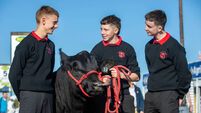Watch for retained foetal membranes
Spring calving is about to get into full swing in dairy and beef herds.
I have visited quite a few farms over the last week where some of the early calvers have been holding their afterbirth.
This issue needs to be addressed immediately.
Most would associate this condition with high yielding dairy cows, but that is very far from the truth. Yes, most of the problems I have seen in the last week were in dairy herds, but not exclusively so.
Suckler herds are not immune from holding their afterbirth.
It has far reaching consequences when it comes to subsequent fertility of the affected cows.
Held cleanings will more often than not result in womb infections and metritis.
Many of the vets that I have spoken to over the winter had suggested that silage could cause problems this spring.
They maintained that due to the poor quality of silage produced last year, cows would be at risk of metabolic disorders after calving.
Where the silage has not been balanced correctly for minerals, this has resulted in many issues for cows at calving.
You need to take a close look at your dry cow diet and management if you want to nip the problem of retained foetal membranes in the bud quickly.
* Are cows over or under conditioned at calving?
* Are you disturbing cows in early labour?
* Are cows getting enough energy in their diet? Are they getting too much energy in their diet?
* Is the silage quality good enough? Are cows unable to eat enough feed, due to quality issues?
* Is a sufficient supply of clean water available before and after calving?
* Are young cows or heifers being bullied in the group?
* Are you feeding concentrates to dry cows? Are you feeding enough concentrates? Are you using the correct concentrate, what protein is it?
* What dry cow mineral are you feeding? Are your dry cows getting any minerals, or sufficient minerals (check the recommended rate on the bags)? Is the dry cow mineral good enough to match your forage and concentrate base?
* How are you managing fresh cows? Are they eating and drinking sufficiently in the hours after calving?
Among the above questions lies the most likely answer to your problem. It may be one specific issue or a combination of a few.
Ensure that your cow’s environment is comfortable and suitable for purpose.
Make sure that you have supplied the cow’s basic nutrient requirements, for energy, protein, fibre, macro minerals, micro minerals, vitamins and water.
Seek advice from your vet and nutrition advisor as soon as possible. It is a good idea to get both parties to consult with each other regarding your problem, as it may result in a quicker resolution.
If you have had a run of held cleanings, don’t wait to “see how the next few get on”.
If silage is the cause of your problems, then you must try to dilute its effects by feeding straw, and perhaps balancing that with some concentrates.
The right mineral is critical for your dry cow, particularly if you start to encounter problems.
The difference in cost is tiny between a cheap, poor quality mineral and the right mineral, made of good quality ingredients in the correct proportions. In many cases, less than €2 per cow extra will buy the right mineral for your herd.
If you have weak calves that are slow to stand up or drink after birth, that is another sign that your dry cow diet needs to be adjusted.
Once you have a calf on the ground, and have ensured it has sufficient colostrum, what next?
How long can you leave the cow and calf in a straw bed on their own? The longer the better, for bonding to occur. This will also allow you to monitor the cow’s feed intake before she returns to the herd with her new offspring.
This critical period after calving can have a huge bearing on the cow’s subsequent fertility performance.









